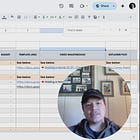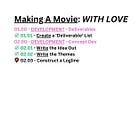Save Your Ass... Why Every Filmmaker Should Capture Background Plates: The Secret to Effortless Reshoots
Discover how capturing background plates can simplify reshoots, reduce costs, and give filmmakers more flexibility with greenscreen technology.
From the school carpool lane…
Monday, December 9th
Hey Filmmaker,
As a filmmaker, reshoots are inevitable.
Whether it’s fixing continuity errors, adding a missed shot, or improving a performance, they’re part of the process.
But here’s the hard truth: reshoots can be expensive, logistically challenging, and time-consuming.
Now imagine this: instead of hauling your cast and crew back to a location, or scrambling to rebuild an entire set, you solve the problem with a greenscreen and a background plate you captured during your initial shoot.
It’s a simple trick that every filmmaker should know—yet it’s often overlooked.
Capturing high-quality background plates of your filming locations can be a lifesaver when reshoots come knocking.
In this post, we’ll explore why background plates matter, how to use them, and how they’ve been a secret weapon for some of the biggest films in Hollywood.
How Capturing Background Plates Can Save Your Film Reshoots (and Your Budget)
THE MODERN FILMMAKER
This Issue: Why Every Filmmaker Should Capture Background Plates: The Secret to Effortless Reshoots…
Last Issue: Why Every Filmmaker Needs an Electronic Press Kit (EPK) to Promote Their Film…
On Sale Now: The Modern Filmmaker’s On Set Filmmaking Dictionary.
So There I Was… (Story)
So there I was, sitting in the editing room, reviewing the final cut of a short film I’d directed.
Everything looked solid—until I noticed a small, glaring problem.
One pivotal scene, shot in a cozy café, had a continuity error.
A coffee cup that was supposed to be empty was suddenly full in one take.
The fix was simple: a quick insert shot of the actor setting the empty cup down.
But there was a huge problem:
The café location wasn’t available anymore.
The set was gone, the lighting had changed, and re-creating the environment seemed impossible without blowing the budget.
Then I remembered something: we had captured a clean background plate of the café—just an empty shot of the room with no actors or movement.
All we needed to fix the scene was a greenscreen, an actor, and that plate.
The reshoot took an hour.
We dropped the actor into the café background using the plate, and the final edit was seamless.
What could have been a costly and stressful reshoot turned into a quick, affordable fix—all because we had the foresight to capture background plates.
What Are Background Plates?
A background plate is a clean shot of your filming location without any actors, props, or action.
Think of it as a “blank canvas” of your set.
These plates can later be used in post-production to composite actors, props, or effects using greenscreen technology.
Plates are typically captured during the initial shoot—when you already have access to the location and the set is dressed exactly how it appears in your scenes.
Why Are Background Plates Important for Filmmakers?
1. They Make Reshoots Simple
If you have a background plate of your location, you can reshoot scenes without needing to return to the actual set or location.
Simply set up a greenscreen, match the lighting, and composite the footage into the original background.
2. They Save Time and Money
Returning to a location can be costly, especially if it involves travel, location fees, or rebuilding a set.
With a background plate, reshoots can often be done in a studio with minimal crew and resources.
3. They Offer Creative Flexibility
Background plates can also be used for creating new shots or scenes you didn’t plan for originally.
Need a close-up or reaction shot that wasn’t in the script?
As long as you have the plate, you have options.
4. They Future-Proof Your Project
In filmmaking, you never know when you’ll need additional footage—even years after the initial shoot.
Having background plates gives you the flexibility to revisit locations virtually without needing to start from scratch.
How to Capture Background Plates
1. Plan Ahead
During pre-production, identify the key locations where background plates might be needed.
Communicate this to your cinematographer and production team so they can allocate time for it on set.
2. Capture Multiple Angles
Make sure to capture plates from every angle used in your scene.
Wide shots, over-the-shoulder views, and close-ups—cover them all to ensure flexibility during post-production.
3. Match Lighting and Set Dressing
The background plate should look identical to the actual scene.
Ensure the set is fully dressed, and the lighting is the same as it is during the main shoot.
4. Record in High Resolution
Capture your plates in the highest resolution possible.
This ensures you can scale and manipulate the image in post without losing quality.
5. Keep the Camera Static
Use a tripod or locked-down rig to ensure the background plate is stable.
Movement in the plate can create challenges during compositing.
Examples of Background Plate Use in Iconic Films
1. The Social Network
David Fincher is a master of seamless visual effects.
In The Social Network, background plates were used extensively for scenes involving the Winklevoss twins.
Actor Armie Hammer played both twins, and the use of plates allowed Fincher to composite Hammer’s performance into a single frame, creating the illusion of two distinct characters.
2. Avengers: Endgame
Marvel films often rely on background plates for their VFX-heavy scenes.
Many sequences in Avengers: Endgame, particularly those in otherworldly locations, used plates combined with greenscreen footage to place actors in environments that didn’t physically exist.
3. Forrest Gump
Background plates were crucial in creating Forrest Gump’s iconic historical moments.
For example, in the scene where Forrest shakes hands with President John F. Kennedy, plates of historical footage were composited with Tom Hanks’ performance, blending reality and fiction seamlessly.
🎬 Take the Next Step in Your Filmmaking Journey
Filmmaking is daunting—you know the vision in your head, but turning it into reality feels impossible without clear guidance and tools.
Imagine having a front-row seat to a movie being made and walking away with all the templates, resources, and inspiration you need to make your own.
The WITH LOVE All-Access Pass is your ticket to demystifying the filmmaking process, offering an unparalleled behind-the-scenes experience and every resource in one bundle.
How Background Plates Simplify Reshoots with Greenscreen
Step 1: Set Up the Greenscreen
To reshoot a scene, place your actor in front of a greenscreen.
Ensure the lighting matches the original scene as closely as possible.
Step 2: Composite the Actor
Using software like Adobe After Effects or DaVinci Resolve, composite the greenscreen footage of your actor onto the background plate.
Adjust for scale, perspective, and lighting to create a seamless blend.
Step 3: Refine the Details
Add any necessary finishing touches, like shadows or reflections, to enhance realism.
This step ensures the actor appears naturally integrated into the background.
Common Challenges (and How to Overcome Them)
1. Lighting Mismatches
Problem: If the lighting in your greenscreen footage doesn’t match the background plate, the final composite will look unnatural.
Solution: Pay close attention to the direction, color temperature, and intensity of the lighting. Use reference images from the original shoot to guide your setup.
2. Resolution Differences
Problem: If your background plate is lower resolution than your greenscreen footage, the composite will look pixelated or blurry.
Solution: Always capture plates in the highest resolution possible.
3. Perspective Issues
Problem: If the camera angle doesn’t match between the plate and the greenscreen footage, the final image will look off.
Solution: Use a consistent lens and camera setup when capturing plates and shooting greenscreen footage.
Why Capturing Background Plates Matters: Key Takeaways
Here’s why capturing background plates should be standard practice for every filmmaker:
Simplifies Reshoots: Avoid the hassle and cost of returning to locations.
Saves Time and Money: Reshoots can be done in a studio, not on-location.
Future-Proofs Your Film: Gives you flexibility to revisit locations digitally.
Expands Creative Options: Allows you to add new shots or reimagine scenes.
Reduces Risk: Provides a safety net for unexpected issues in post-production.
Final Thoughts
As a filmmaker, preparation is your greatest ally.
Capturing background plates may seem like a small, extra step on set, but it can save you massive headaches in post-production.
Whether you’re fixing continuity errors, adding new shots, or working on a VFX-heavy project, background plates give you the flexibility to adapt without breaking the bank.
So next time you’re on set, take a few extra minutes to capture those plates. Your future self—and your budget—will thank you.
Until next time, filmmaker—plan ahead, shoot smart, and keep creating.
Cheers,
Mike Rekola
P.S. Catch up on the rest from TheModernFilmmaker.co:
👉 Buy: The Modern Filmmaker’s On Set Filmmaking Dictionary, today.
👉 Some Filmmakers to Know: Jim Jarmusch & Claude Chabrol…
👉 Some Filmmaking Terms: Above-the-Line & Back to First Marks…
👉 Some Stories: So there I was… Writing a Screenplay that Sucked…
👉 Some Thoughts: Why Risk is the Key to Relationships…
👉 Meet Me: Mike Rekola…











